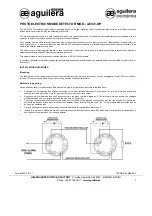
5
56
6
© 2005 Directed Electronics, Inc. Vista, CA
ttrroouubblleesshhoooottiinngg
■
SSh
ho
occkk sseen
nsso
orr d
do
oeessn
n''tt ttrriig
gg
geerr tth
hee aallaarrm
m::
Has the NPC™ system been triggered? If so, you will hear 5 chirps when disarming. To check this, turn the igni-
tion key on and off to clear the NPC™'s memory, and then retest the shock sensor. For a detailed description of
NPC™, see
Nuisance Prevention Circuitry section of this guide.
■
D
Do
oo
orr iin
np
pu
utt d
do
oeess n
no
ott iim
mm
meed
diiaatteellyy ttrriig
gg
geerr ffu
ullll aallaarrm
m.. IIn
nsstteeaad
d,, cch
hiirrp
pss aarree h
heeaarrd
d ffo
orr tth
hee ffiirrsstt 3
3 sseecco
on
nd
dss::
That's how the progressive two-stage door input works! This is a feature of this system. This is an instant trigger,
remember, since even if the door is instantly closed again, the progression from chirps to constant siren will continue.
■
CCllo
ossiin
ng
g tth
hee d
do
oo
orr ttrriig
gg
geerrss tth
hee ssyysstteem
m,, b
bu
utt o
op
peen
niin
ng
g tth
hee d
do
oo
orr d
do
oeess n
no
ott::
Have you correctly identified the type of door switch system? This happens often when the wrong door input has
been used. (See
Door Lock Harness Wire Connection Guide section of this guide.)
■
SSyysstteem
m w
wiillll n
no
ott p
paassssiivveellyy aarrm
m u
un
nttiill iitt iiss rreem
mo
otteellyy aarrm
meed
d aan
nd
d tth
heen
n d
diissaarrm
meed
d::
Are the door inputs connected? Is the H1/6 blue wire connected to the door trigger wire in the vehicle? Either
the H1/5 green or the H1/7 violet should be used instead. (See wiring diagrams.)
■
D
Do
oo
orr iin
np
pu
utt d
do
oeess n
no
ott rreessp
po
on
nd
d w
wiitth
h tth
hee p
prro
og
grreessssiivvee ttrriig
gg
geerr,, b
bu
utt w
wiitth
h iim
mm
meed
diiaattee ffu
ullll aallaarrm
m::
Does the Status LED indicate that the trigger was caused by the shock sensor? (See
Diagnostics section of this
guide.) The shock sensor, if set to extreme sensitivity, may be detecting the door unlatching before the door
switch sends its signal. Reducing the sensitivity can solve this problem.
■
TTh
hee V
Vaalleett®
®//P
Prro
og
grraam
m ssw
wiittcch
h d
do
oeessn
n''tt w
wo
orrkk..
Is it plugged into the correct socket? See
Plug-In LED and Valet®/Program Switch section of this guide.
■
SSttaattu
uss LLEED
D d
do
oeessn
n''tt w
wo
orrkk..
You've probably guessed already, but here goes: Is it plugged in? (See
Plug-In LED and Valet®/Program Switch
section of this guide.) Is the LED plugged into the correct socket?
■
D
Do
oo
orr llo
occkkss o
op
peerraattee b
baacckkw
waarrd
dss..
This unit has easily-reversed lock/unlock outputs. Recheck wire connections to see if you have reversed these.
■
TTh
hee rreem
mo
ottee ssttaarrtt w
wiillll n
no
ott aaccttiivvaattee..
1. Check the harnesses and their connections. Make sure that the harnesses are completely plugged into the
remote start module. Make sure there are good connections to the vehicle wiring.
rreem
moottee ssttaarrtt ttrroouubblleesshhoooottiinngg
aallaarrm
m ttrroouubblleesshhoooottiinngg





































